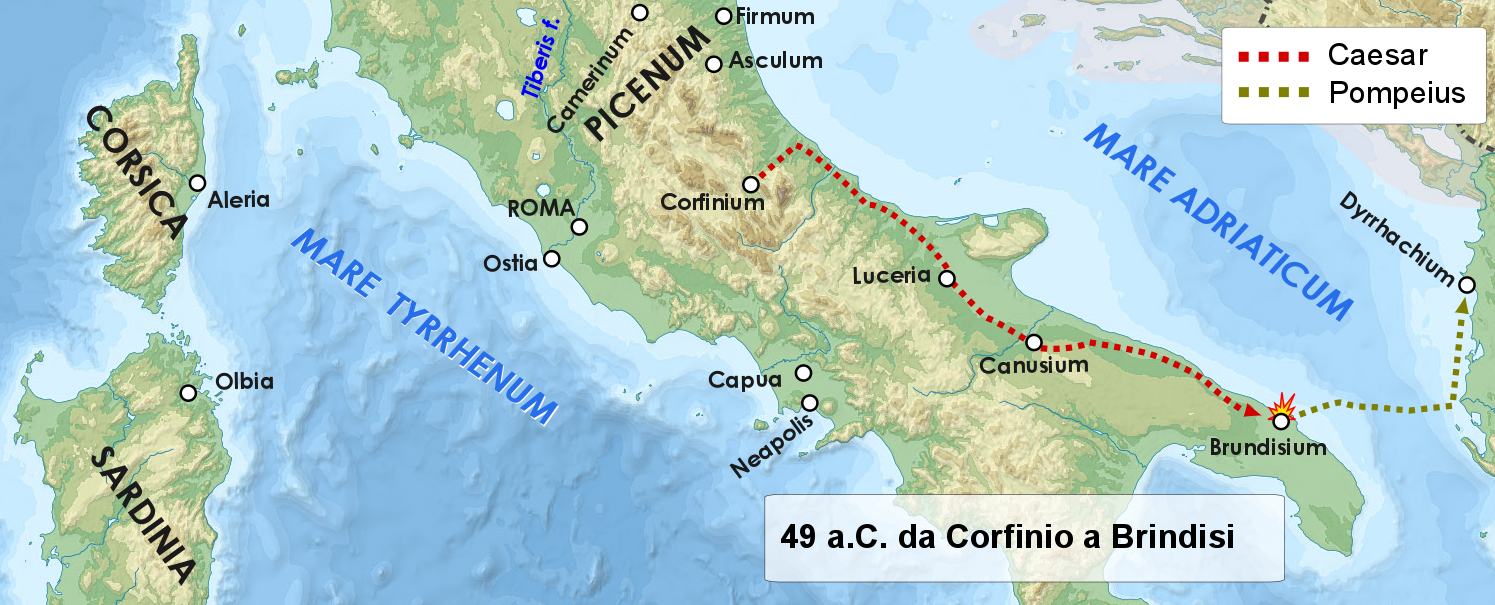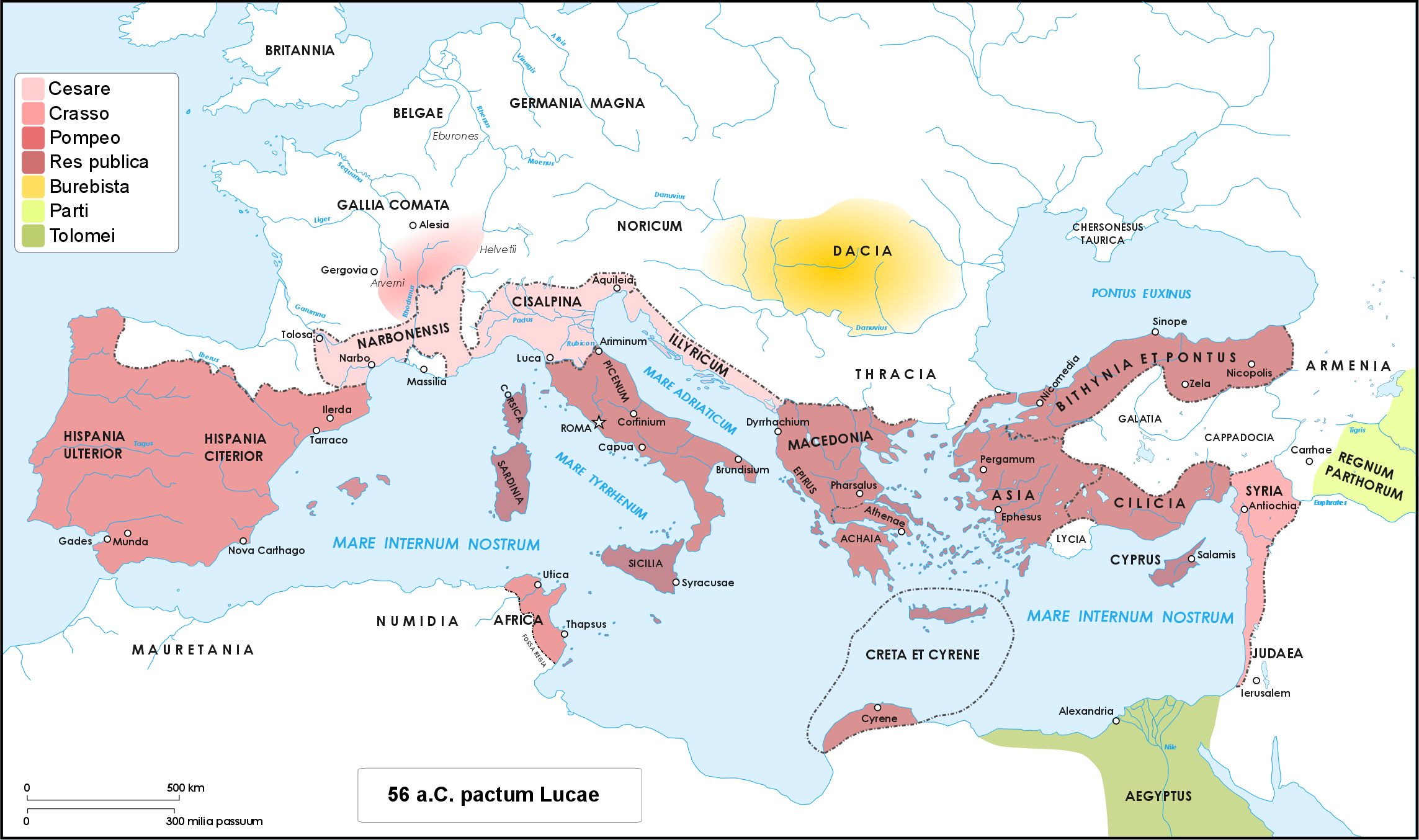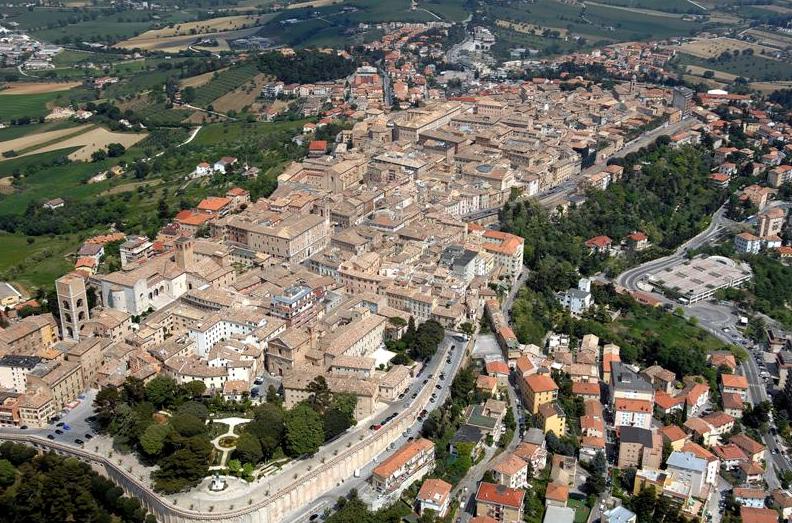|
Siege Of Brundisium
The siege of Brundisium was an early military confrontation of Caesar's Civil War. Taking place in March 49 BC, it saw the forces of Gaius Julius Caesar's Populares besiege the Italian city of Brundisium on the coast of the Adriatic Sea which was held by a force of Optimates under the command of Gnaeus Pompeius Magnus. After a series of brief skirmishes, during which Caesar tried to blockade the harbour, Pompey abandoned the city and managed to evacuate his men across the Adriatic to Epirus. Pompey's retreat meant that Caesar had full control over the Italian Peninsula, with no way to pursue Pompey's forces in the east he instead decided to head west to confront the legions Pompey had stationed in Hispania. Background Escalating tensions over the previous decade between Gaius Julius Caesar and the Roman Senate, rallying around Gnaeus Pompeius Magnus ("Pompey the Great"), culminated in Caesar crossing the Rubicon river in January 49 BC and thus being labelled as an enemy of the p ... [...More Info...] [...Related Items...] OR: [Wikipedia] [Google] [Baidu] |
Caesar's Civil War
Caesar's civil war (49–45 BC) was one of the last politico-military conflicts of the Roman Republic before its reorganization into the Roman Empire. It began as a series of political and military confrontations between Gaius Julius Caesar and Gnaeus Pompeius Magnus. Before the war, Caesar had led an invasion of Gaul for almost ten years. A build-up of tensions starting in late 49 BC, with both Caesar and Pompey refusing to back down led, however, to the outbreak of civil war. Eventually, Pompey and his allies induced the Senate to demand Caesar give up his provinces and armies. Caesar refused and instead marched on Rome. The war was a four-year-long politico-military struggle, fought in Italy, Illyria, Greece, Egypt, Africa, and Hispania. Pompey defeated Caesar in 48 BC at the Battle of Dyrrhachium, but was himself defeated decisively at the Battle of Pharsalus. Many former Pompeians, including Marcus Junius Brutus and Cicero, surrendered after the battle, wh ... [...More Info...] [...Related Items...] OR: [Wikipedia] [Google] [Baidu] |
Italia (Roman Province)
Roman Italy (called in both the Latin and Italian language, Italian languages referring to the Italian Peninsula) was the homeland of the ancient Rome, ancient Romans and of the Roman provinces, Roman empire. According to Roman mythology, Italy was the ancestral home promised by Jupiter (god), Jupiter to Aeneas, Aeneas of Troy and his descendants, Romulus and Remus, who were the founding of Rome, founders of Rome. Aside from the legendary accounts, Rome was an Italic city-state that changed its form of government from Kingdom of Rome, Kingdom to Roman Republic, Republic and then grew within the context of a peninsula dominated by the Cisalpine Gaul, Gauls, Ligures, Adriatic Veneti, Veneti, Camunni and Histri in the Northern Italy, North, the Etruscans, Latins (Italic tribe), Latins, Falisci, Picentes and Umbrian, Umbri tribes (such as the Sabines) in the Central Italy, Centre, and the Iapygians, Iapygian tribes (such as the Messapians), the Osci, Oscan tribes (such as the Samnites ... [...More Info...] [...Related Items...] OR: [Wikipedia] [Google] [Baidu] |
Apulia
it, Pugliese , population_note = , population_blank1_title = , population_blank1 = , demographics_type1 = , demographics1_footnotes = , demographics1_title1 = , demographics1_info1 = , demographics1_title2 = , demographics1_info2 = , demographics1_title3 = , demographics1_info3 = , timezone1 = CET , utc_offset1 = +01:00 , timezone1_DST = CEST , utc_offset1_DST = +02:00 , postal_code_type = , postal_code = , area_code_type = ISO 3166 code , area_code = IT-75 , blank_name_sec1 = GDP (nominal) , blank_info_sec1 = €76.6 billion (2018) , blank1_name_sec1 = GDP per capita , blank1_info_sec1 = €19,000 (2018) , blank2_name_sec1 = HDI (2018) , blank2_info_sec1 = 0.845 · 18th of 21 , blank_name_sec2 = NUTS Region , blank_info_sec2 = ... [...More Info...] [...Related Items...] OR: [Wikipedia] [Google] [Baidu] |
Lucius Domitius Ahenobarbus (consul 54 BC)
Lucius Domitius Ahenobarbus, consul in 54 BC, was an enemy of Julius Caesar and a strong supporter of the aristocratic () party in the late Roman Republic. Biography Ahenobarbus was born as the son of consul Gnaeus Domitius Ahenobarbus. His grandfather Gnaeus Domitius Ahenobarbus was a general and consul who led a campaign to conquer southern Gaul against the Allobroges. He is first mentioned in 70 BC by Cicero as a witness against Verres. In 61, he was curule aedile, when he exhibited a hundred Numidian lions, and continued the games so long that the people were obliged to leave the circus before the exhibition was over, in order to take food, which was the first time they had done so. This pause in the games was called ''diludium''. He married Porcia, the sister of Cato the Younger, and in his aedileship supported the latter in his proposals against bribery at elections, which were directed against Pompey, who was purchasing votes for Afranius. The political opinions ... [...More Info...] [...Related Items...] OR: [Wikipedia] [Google] [Baidu] |
Corfinium
Corfinium (Greek: ) was a city in ancient Italy, on the eastern side of the Apennines, due east of Rome, near modern Corfinio, in the province of L'Aquila (Abruzzo region). History Corfinium was the chief city of the Paeligni, situated in the valley of the Aternus, near the point where that river's course suddenly makes a sharp turn and runs from southeasterly to northeasterly on towards the Adriatic Sea. It was distant 7 miles from Sulmo (modern Sulmona), and 30 from Alba Fucens by the Via Valeria. There can be no doubt that Corfinium was from an early period the capital city of the Paeligni, and one of the chief towns in this part of Italy; but no mention of its name is found in history until the outbreak of the Social War, in 90 BCE, when it was selected by the confederates to be their common capital, and the seat of their government. It was probably to the importance of its situation in a military point of view that it was mainly indebted for this distinction; but the allie ... [...More Info...] [...Related Items...] OR: [Wikipedia] [Google] [Baidu] |
Asculum
Asculum, also known as Ausculum, was the ancient name of two Italian cities. The first is Ascoli Piceno, the ''Ausculum'' in ancient Picenum (modern Marche). It is situated in the valley of the Truentus (mod. Tronto) river on the via Salaria. It was originally a Sabine city (Festus 235.16-17). Following its defeat by the Romans in 268 BC (Eutr. 2,16), Asculum became a ''civitas foederata''. It was the first Italian city to rise up against Rome in 90 BC during the Social War (91–88 BC), Social War. An account described the city as home to a war-like people that bore generation-old grudge against Rome for encroaching on its northern territories. It was besieged and captured following the Battle of Asculum (89 BC). Discovered artifacts in the city such as sling bullets show that the siege included at least four Roman legions as well as Gaul, Gallic and Spaniards, Spanish Auxilia, auxiliaries. Following the war, it became a municipium. In the Triumvirate, triumviral period or unde ... [...More Info...] [...Related Items...] OR: [Wikipedia] [Google] [Baidu] |
Auximum
Osimo is a town and ''comune'' of the Marche region of Italy, in the province of Ancona. The municipality covers a hilly area located approximately south of the port city of Ancona and the Adriatic Sea. , Osimo had a total population of 35,037. History Vetus Auximum was founded by the same Greek colonists of Ancona; later it was contested by the Gauls and the Picentes until conquered by the Romans, who used it as a fortress for their northern Picenum settlement starting from 174 BCE. The walls were made of large rectangular stones which are still visible in some locations. It was a colony until 157 BCE. The family of Pompey were its protectors and resisted Julius Caesar in 49 BCE. Inscriptions and monuments in its town square attest to the importance of Osimo during imperial times. In the 6th century it was besieged twice in the course of the Gothic War (535–554) by Belisarius and Totila; the Byzantine historian Procopius said it was the leading town of Picenum. Osimo was ... [...More Info...] [...Related Items...] OR: [Wikipedia] [Google] [Baidu] |
Arretium
Arezzo ( , , ) , also ; ett, 𐌀𐌓𐌉𐌕𐌉𐌌, Aritim. is a city and ''comune'' in Italy and the capital of the province of the same name located in Tuscany. Arezzo is about southeast of Florence at an elevation of above sea level. As of 2022, the population was about 97,000. Known as the city of gold and of the high fashion, Arezzo was home to artists and poets such as Giorgio Vasari, Guido of Arezzo and Guittone d'Arezzo and in its province to Renaissance artist Michelangelo. In the artistic field, the city is famous for the frescoes by Piero della Francesca inside the Basilica of San Francesco, and the crucifix by Cimabue inside the Basilica of San Domenico. The city is also known for the important Giostra del Saracino, a game of chivalry that dates back to the Middle Ages. History Described by Livy as one of the ''Capita Etruriae'' (Etruscan capitals), Arezzo (''Aritim'' in Etruscan) is believed to have been one of the twelve most important Etruscan citi ... [...More Info...] [...Related Items...] OR: [Wikipedia] [Google] [Baidu] |
Crossing The Rubicon
The phrase "crossing the Rubicon" is an idiom that means "passing a point of no return". Its meaning comes from allusion to the crossing of the river Rubicon by Julius Caesar in early January 49 BC. The exact date is unknown. Scholars usually place it on the night of 10 and 11 January, based on speeds at which messengers could travel at that time. His crossing of the river precipitated Caesar's civil war, which ultimately led to Caesar's becoming dictator for life (''dictator perpetuo)''. Caesar had been appointed to a governorship over a region that ranged from southern Gaul to Illyricum. As his term of governorship ended, the Senate ordered him to disband his army and return to Rome. As it was illegal to bring armies into Italy (the northern border of which was marked by the river Rubicon) his crossing the river under arms amounted to insurrection, treason, and a declaration of war on the state. According to some authors, he uttered the phrase ''alea iacta est'' ("the ... [...More Info...] [...Related Items...] OR: [Wikipedia] [Google] [Baidu] |
Roman Senate
The Roman Senate ( la, Senātus Rōmānus) was a governing and advisory assembly in ancient Rome. It was one of the most enduring institutions in Roman history, being established in the first days of the city of Rome (traditionally founded in 753 BC). It survived the overthrow of the Roman monarchy in 509 BC; the fall of the Roman Republic in the 1st century BC; the division of the Roman Empire in AD 395; and the fall of the Western Roman Empire in 476; Justinian's attempted reconquest of the west in the 6th century, and lasted well into the Eastern Roman Empire's history. During the days of the Roman Kingdom, most of the time the Senate was little more than an advisory council to the king, but it also elected new Roman kings. The last king of Rome, Lucius Tarquinius Superbus, was overthrown following a coup d'état led by Lucius Junius Brutus, who founded the Roman Republic. During the early Republic, the Senate was politically weak, while the various executive magistr ... [...More Info...] [...Related Items...] OR: [Wikipedia] [Google] [Baidu] |
Hispania
Hispania ( la, Hispānia , ; nearly identically pronounced in Spanish, Portuguese, Catalan, and Italian) was the Roman name for the Iberian Peninsula and its provinces. Under the Roman Republic, Hispania was divided into two provinces: Hispania Citerior and Hispania Ulterior. During the Principate, Hispania Ulterior was divided into two new provinces, Baetica and Lusitania, while Hispania Citerior was renamed Hispania Tarraconensis. Subsequently, the western part of Tarraconensis was split off, first as Hispania Nova, later renamed "Callaecia" (or Gallaecia, whence modern Galicia). From Diocletian's Tetrarchy (AD 284) onwards, the south of the remainder of Tarraconensis was again split off as Carthaginensis, and all of the mainland Hispanic provinces, along with the Balearic Islands and the North African province of Mauretania Tingitana, were later grouped into a civil diocese headed by a ''vicarius''. The name Hispania was also used in the period of Visigothic rule. The mod ... [...More Info...] [...Related Items...] OR: [Wikipedia] [Google] [Baidu] |



.jpg)




_02.jpg)